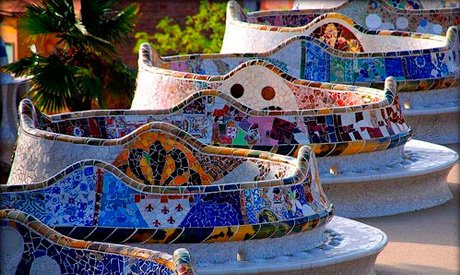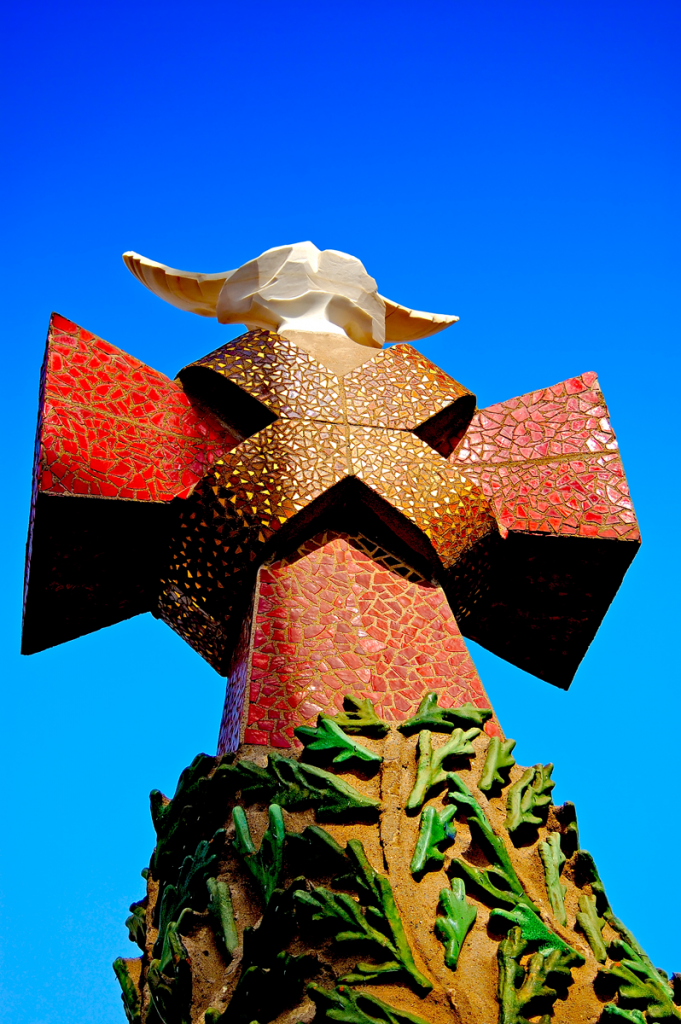The Best Gaudí Mosaics From Around the World

Revered Spanish architect Antonio Gaudí has been in the news in recent years. You’ve likely heard about the ongoing work at Barcelona’s La Sagrada Familia cathedral – scheduled for completion in 2026.

You’re also likely to associate his works with mosaic art. As a master architect, Gaudí was known for his attention to the smallest of details. Everything, he believed, could be both functional and beautiful – indoors and outdoors.
His use of mosaic pattern was sometimes subtle, sometimes flamboyant. He used single colors to emphasize some architectural features and shapes. Others varied size and color to create effects like being underwater or scales on a lizard.
Gaudí favored the trencadis technique of mosaic art, which used irregular pieces of ceramic, glass or marble tiles. According to biographers, this began with a trip to a ceramics workshop where Lluís Bru was working on a commission. Impatient with the slow progress of the glass mosaic designs, place, Gaudí seized a tile and broke it into pieces, telling the artist:
“We have to put them on by the handful, like this, or we’ll never finish!”

We’ll be visiting some of his beautiful designs in our blog, letting you travel to them safely! Although much of his work was on building exteriors, we’ll also see some public parks and mosaic designs in building interiors.
1. Casa Batllo, Barcelona
This marine-inspired former residence is a good introduction to Gaudí’s modernist, Art Nouveau style. When he took on the transformation of this home for new owners, the new, non-linear design elements worked well with mosaic designs.

Outside, the facade of the structure known to locals as the “Casa dels ossos”, or House of Bones, has recently been restored.

Gaudí’s mosaic patterns are a key part of the whole theme. Through their use, the exterior seems to ripple with movement. There’s also a tribute to St. George built into the structure. See how the back of the dragon he slew curves along the rooftop?

You can tour this wonderful landmark virtually right now, by visiting this Casa Battlo virtual tour.
2. La Pedrera, Barcelona

Designated UNESCO World Heritage Site, this expansive structure hides its mosaic magic on the rooftop. Its name means “The Quarry”, which describes the way the building seems to have sprouted and grown from stone.
With nine levels, including a garage, apartments, and a sculpture terrace, it was controversial in 1912 – but a popular tourist attraction today. On the roof, functional elements like skylights and staircase exits, chimneys, and vents became art.

Today, nighttime events light up the mosaic artwork in an audiovisual display. We think Gaudí might approve of this lively use of technology.

3. Parc Güell, Barcelona

The lovely Parc Güell opened in 1926. Here, Gaudí was able to explore his ideas about organic shapes, geometry, and color. Fantastic shapes and joyful colors predominate. You’ll see Gaudí mosaics everywhere here. Benches, columns, rooftop spires and fountains all glisten with glass mosaic art and ceramic tiles.
The architect liked to sprinkle symbolism into his mosaic art embellishments. While strolling around the gardens, visitors can hunt for signs of religious imagery, puzzles, mythology, history, and politics of the time.

4. El Capricho, Comillas, Cantabria, Spain

Early in his career, the 31-year old Gaudí experimented with Orientalist inspiration. Here, at one of his few commissions outside his native Catalonia, he built a summer home for one Máximo Díaz de Quijano. The Capricho, named after the freely styled music of the time, has a tiled tower that resembles a minaret.
The color scheme is quite different from most of Gaudí’s work. In this setting, surrounded by the hills of Northern Spain, he added green to the oranges and reds of the tiles. Other than the happy color scheme, he chose sunflowers as the main motif for the villa.

5. Güell Pavilion, Barcelona, Spain
You’ll see the name of count Eusebi Güell pop up frequently in association with Gaudí. He was the architect’s best patron. For this project, he remodeled a home on an estate that was located in Sarria – which is now part of modern Barcelona. The remaining structures are related to the count’s equestrian pursuits.
The architect proposed a design inspired by Mudejar art – the Islamic-influenced style that was popular at the time.

The ornate style can still be seen on the remaining gates and above the walls. The dome over the lunging ring (used for training horses) is richly embellished with small tiles and glass mosaic.
Across the property, ventilators in the style of chimneys are adorned with mosaic patterns in both glass and ceramic tiles.

Today this site is the site of the Royal Gaudí Chair, a part of the Barcelona Polytechnic University.
6. Church of Sant Pacià, Barcelona, Spain

As a student of the architect Joan Torras i Guardiola, the young Gaudí was responsible for the mosaic design of the floors in this church.
It’s located in Sant Andreu del Palomar, a quiet part of Barcelona, and the marble mosaic art is not usually on the larger tours that visit his buildings.

It’s believed that Gaudí was inspired by the Romanesque church Sant Pau del Camp when designing the floors. It’s interesting to see his early work and the influences that continued throughout his life.
7. Casa Vicens, Barcelona, Spain
Now a museum, the Casa Vicens was Gaudí’s first house commission. Done in the Neo-Mudejar style, it’s a showcase for his use of mosaic tile, along with bright color, iron ornamentation, and concrete…

Visitors can see extensive use of mosaic tile inside and outside the former summer house, all painstakingly restored. Gaudí’s clients didn’t shy away from ornamentation or flamboyance.

9. Church of Colònia Güell

Another commission from his patron Güell saw Gaudí building a church for workers at Güell’s textile factory. The design was intended to harmonize with the architecture of the workers’ homes already there, as well as with nature.
Gaudí responded with this stone structure. The interplay of mosaic patterns and raw basaltic stone is a wonderful contrast. Although the church was never completed to his plans, the use of mosaic and the overall structure is definitely echoed in his iconic Sagrada Familia.

10. Basilica Sagrada Familia, Barcelona, Spain
Gaudí’s penultimate project was this massive church. Although he died nearly a century before its anticipated completion, he will be forever linked to it. As in all his works, mosaic art is a key part of the ornamentation.

Towering over the city at 170 m in the air, the mosaic touches begin in the sky, and continue downwards.

Each of the eight bell towers are decorated with mosaic art.


Each nave is adorned with mosaic fruit, representing seasons of the year.

Here, the wheat and grapes represent the sacrament.

If you’re putting off your trip to Spain this year, don’t forget that you can enjoy Gaudí-inspired beauty with some of our favorite mosaic wall art selections. Bring a touch of Barcelona to your home or garden with colorful geometric designs that resemble the Church of Sant Pacià floors, or with a basket of glowing glass mosaic fruits.
Or perhaps one of Gaudí’s beloved dragons.
Please visit our extensive catalog of mosaic art designs for more inspiration and ideas to customize your own mosaic decorations!













